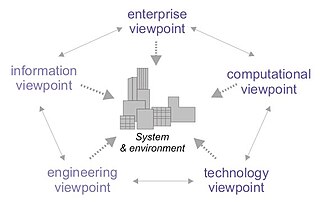ANSI C, ISO C and Standard C are successive standards for the C programming language published by the American National Standards Institute (ANSI) and the International Organization for Standardization (ISO). Historically, the names referred specifically to the original and best-supported version of the standard. Software developers writing in C are encouraged to conform to the standards, as doing so helps portability between compilers.
MPEG-4 is a method of defining compression of audio and visual (AV) digital data. It was introduced in late 1998 and designated a standard for a group of audio and video coding formats and related technology agreed upon by the ISO/IEC Moving Picture Experts Group (MPEG) under the formal standard ISO/IEC 14496 – Coding of audio-visual objects. Uses of MPEG-4 include compression of AV data for web and CD distribution, voice and broadcast television applications. The MPEG-4 standard was developed by a group led by Touradj Ebrahimi and Fernando Pereira.
The Portable Document Format (PDF) is a file format developed by Adobe in 1993 to present documents, including text formatting and images, in a manner independent of application software, hardware, and operating systems. Based on the PostScript language, each PDF file encapsulates a complete description of a fixed-layout flat document, including the text, fonts, vector graphics, raster images and other information needed to display it. PDF was standardized as ISO 32000 in 2008, and no longer requires any royalties for its implementation.
SQL is a domain-specific language used in programming and designed for managing data held in a relational database management system (RDBMS), or for stream processing in a relational data stream management system (RDSMS). It is particularly useful in handling structured data, i.e. data incorporating relations among entities and variables.

JPEG 2000 (JP2) is an image compression standard and coding system. It was developed from 1997 to 2000 by a Joint Photographic Experts Group committee chaired by Touradj Ebrahimi, with the intention of superseding their original discrete cosine transform (DCT) based JPEG standard with a newly designed, wavelet-based method. The standardized filename extension is .jp2 for ISO/IEC 15444-1 conforming files and .jpx for the extended part-2 specifications, published as ISO/IEC 15444-2. The registered MIME types are defined in RFC 3745. For ISO/IEC 15444-1 it is image/jp2.

VRML is a standard file format for representing 3-dimensional (3D) interactive vector graphics, designed particularly with the World Wide Web in mind. It has been superseded by X3D.
The Call Level Interface (CLI) is an application programming interface (API) and software standard to embed Structured Query Language (SQL) code in a host program as defined in a joint standard by the International Organization for Standardization (ISO) and International Electrotechnical Commission (IEC): ISO/IEC 9075-3:2003. The Call Level Interface defines how a program should send SQL queries to the database management system (DBMS) and how the returned recordsets should be handled by the application in a consistent way. Developed in the early 1990s, the API was defined only for the programming languages C and COBOL.
X3D is a royalty-free ISO/IEC standard for declaratively representing 3D computer graphics. File format support includes XML, ClassicVRML, Compressed Binary Encoding (CBE) and a draft JSON encoding. X3D became the successor to the Virtual Reality Modeling Language (VRML) in 2001. X3D features extensions to VRML, the ability to encode the scene using an XML syntax as well as the Open Inventor-like syntax of VRML97, or binary formatting, and enhanced application programming interfaces (APIs).

Anim8or is a freeware OpenGL-based 3D modeling and animation program by R. Steven Glanville, a software engineer at NVidia. Currently at stable version 1.0, it is a compact program with several tools which would normally be expected in high-end, paid software. To date, every version released has been under 3 MB, despite the fact that it does not make full use of Windows' native interface, carrying some graphical elements of its own. Although few official tutorials have been posted by the author, many other users have posted their own on sites such as YouTube and the anim8or home page. While Anim8or was once comparable to other freeware 3D animation software such as Blender, it has seen less progression in recent years, with Blender now being more capable than before.
COLLADA is an interchange file format for interactive 3D applications. It is managed by the nonprofit technology consortium, the Khronos Group, and has been adopted by ISO as a publicly available specification, ISO/PAS 17506.
MPEG-4 Part 11Scene description and application engine was published as ISO/IEC 14496-11 in 2005. MPEG-4 Part 11 is also known as BIFS, XMT, MPEG-J. It defines:
Office Open XML is a zipped, XML-based file format developed by Microsoft for representing spreadsheets, charts, presentations and word processing documents. The format was initially standardized by Ecma, and by the ISO and IEC in later versions.
The Web3D Consortium is an international not-for-profit, member-funded industry consortium, originally founded in 1997. In the Web3D Consortium members from governmental, nonprofit and research organizations worldwide, working alongside individual professional members, collaborate in a consensus process encouraging development and implementation of open standards for 3D content and services.

Reference Model of Open Distributed Processing (RM-ODP) is a reference model in computer science, which provides a co-ordinating framework for the standardization of open distributed processing (ODP). It supports distribution, interworking, platform and technology independence, and portability, together with an enterprise architecture framework for the specification of ODP systems.
In color management, an ICC profile is a set of data that characterizes a color input or output device, or a color space, according to standards promulgated by the International Color Consortium (ICC). Profiles describe the color attributes of a particular device or viewing requirement by defining a mapping between the device source or target color space and a profile connection space (PCS). This PCS is either CIELAB (L*a*b*) or CIEXYZ. Mappings may be specified using tables, to which interpolation is applied, or through a series of parameters for transformations.

Seamless3d is an open-source 3D modeling software available under the MIT license.
The Universal Coded Character Set (UCS) is a standard set of characters defined by the International Standard ISO/IEC 10646, Information technology — Universal Coded Character Set (UCS), which is the basis of many character encodings. The latest version contains over 136,000 abstract characters, each identified by an unambiguous name and an integer number called its code point. This ISO/IEC 10646 standard is maintained in conjunction with The Unicode Standard ("Unicode"), and they are code-for-code identical.
Modula-2 is a structured, procedural programming language developed between 1977 and 1985 by Niklaus Wirth at ETH Zurich. It was created as the language for the operating system and application software of the Lilith personal workstation. It was later used for programming outside the context of the Lilith.




